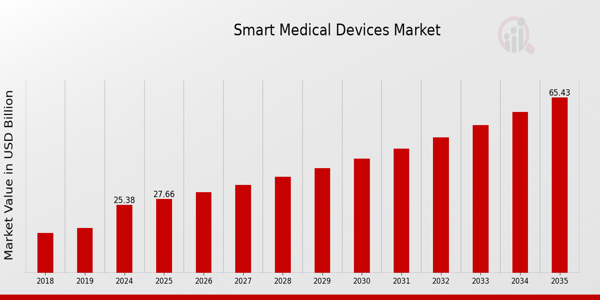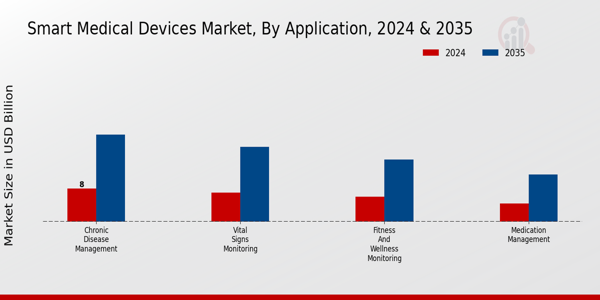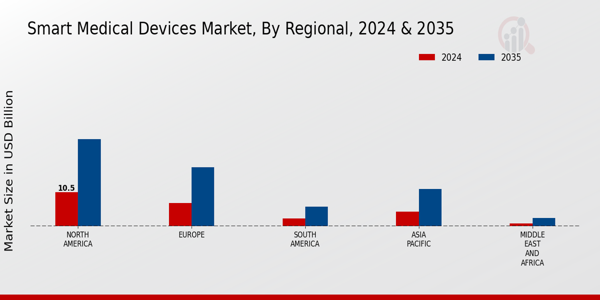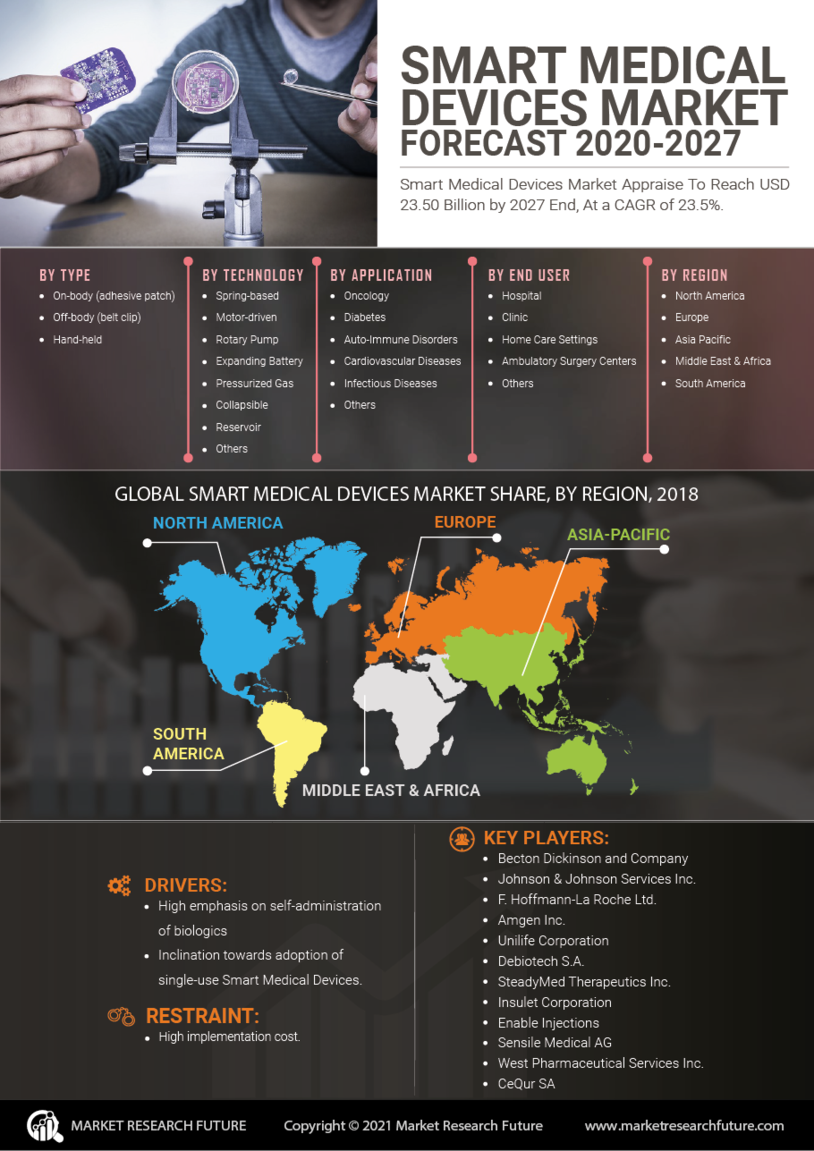Smart Medical Devices Market Summary
As per Market Research Future Analysis, the Smart Medical Devices Market was valued at 23.28 USD Billion in 2023 and is projected to grow to 65.4 USD Billion by 2035, driven by technological advancements and increasing chronic disease prevalence. The market is characterized by a shift towards personalized medicine and remote patient monitoring, particularly in home healthcare settings.
Key Market Trends & Highlights
Key trends driving the Smart Medical Devices Market include technological integration and demographic shifts.
- The market is expected to grow at a CAGR of 8.99% from 2025 to 2035.
- Wearable Devices segment projected to reach 10.0 USD Billion by 2024.
- Chronic Disease Management applications are anticipated to dominate, contributing significantly to market growth.
- North America is expected to hold the largest market share at 10.5 USD Billion in 2024.
Market Size & Forecast
2023 Market Size: USD 23.28 Billion
2024 Market Size: USD 25.38 Billion
2035 Market Size: USD 65.4 Billion
CAGR (2025-2035): 8.99%
Largest Regional Market Share in 2024: North America.
Major Players
Key players include Abbott Laboratories, Insulet Corporation, AliveCor, Baxter International, Roche, Philips, GE Healthcare, Johnson and Johnson, Zebra Medical Vision, Omron Healthcare, NeuroMetrix, Medtronic, Boston Scientific, and Dexcom.
Key Smart Medical Devices Market Trends Highlighted
There are a lot of big changes happening in the Smart Medical Devices Market right now, and they are all caused by different things. The rise in chronic illnesses is one of the main factors driving the market. This has led to a greater need for smart devices that can help with patient monitoring and management. IoT technology makes medical equipment work better by letting it gather and analyse data in real time.
Another big reason is the increased focus on customized healthcare. This is making companies produce new smart gadgets that meet the specific health demands of each person. Advances in artificial intelligence and machine learning, which make devices work better and increase the accuracy of diagnoses, also help this trend.
There are many chances in the Smart Medical Devices Market, especially in emerging countries where healthcare infrastructure is slowly becoming better. Governments are putting money into updating healthcare and becoming digital, which makes it easier for people to use smart medical gadgets.
Also, as more people choose home healthcare options, there is a small market for portable and easy-to-use technologies that let people manage their health problems.
Recent trends reveal that people are becoming more mindful of their health and well-being, which is making them more interested in wearable electronics and remote monitoring gadgets. The COVID-19 pandemic sped up the move toward telemedicine and remote patient monitoring. This showed how important it is for healthcare equipment to be able to connect and keep data safe.
Manufacturers are now putting more emphasis on making devices work together and adding features that make users more engaged because of the rising need for smart solutions. The coming together of these developments signals a turning point for the Smart Medical Devices Market. It points to a future where healthcare is more connected, efficient, and focused on the patient.

Source: Primary Research, Secondary Research, Market Research Future Database and Analyst Review
Smart Medical Devices Market Drivers
Rising Demand for Remote Patient Monitoring
The Smart Medical Devices Market Industry is witnessing a significant increase in demand for remote patient monitoring solutions, particularly driven by the need for continuous health management and personalized patient care. With the global population aging, the World Health Organization indicated that by 2030, there will be 1.4 billion individuals aged 60 and older, leading to a higher prevalence of chronic diseases.
Companies like Philips Healthcare are actively investing in the development of smart medical devices tailored for remote monitoring, which allows healthcare professionals to monitor patient conditions in real-time.This trend highlights the critical need for smart medical devices in effectively managing chronic illnesses, thus propelling the market growth forward.
Technological Advancements in Medical Devices
Technological advancements are revolutionizing the Smart Medical Devices Market Industry, with innovations such as Artificial Intelligence (AI), the Internet of Things (IoT), and machine learning enhancing device functionalities. According to the International Federation of Robotics, the global healthcare robotics market is projected to grow at a compound annual growth rate of 23% from 2018 to 2025. These innovations are being embraced by major companies like GE Healthcare and Siemens Healthineers, who are integrating advanced technology into their product lines.
This relentless focus on Research and Development (R&D) is creating smarter solutions that improve patient outcomes and efficiency, thus driving market growth.
Increased Investment in Healthcare Infrastructure
Governments worldwide are ramping up investments in healthcare infrastructure, which directly benefits the Smart Medical Devices Market Industry. For instance, the European Union has allocated substantial funding under its Health Investment Program to advance healthcare systems and services, focusing on integrating smart technology. Such initiatives are expected to strengthen the adoption of smart medical devices as healthcare institutions work towards modernization.
The growing emphasis on building resilient healthcare capabilities in light of challenges like the COVID-19 pandemic indicates a promising outlook for the smart medical devices segment.
Smart Medical Devices Market Segment Insights
Smart Medical Devices Market Application Insights
The Smart Medical Devices Market is witnessing substantial growth, particularly within the Application segment, which encompasses various critical areas such as Chronic Disease Management, Fitness and Wellness Monitoring, Vital Signs Monitoring, and Medication Management.
In 2024, the market is expected to be valued significantly, reflecting a strong consumer demand for advanced healthcare technology solutions. Chronic Disease Management represents a major component of this segment, valued at 8.0 USD Billion in 2024 and projected to soar to 21.0 USD Billion by 2035.
This sub-segment is significant due to the growing prevalence of chronic diseases globally, prompting the need for efficient monitoring and management solutions. Fitness and Wellness Monitoring is also a key area within the market, valued at 6.0 USD Billion in 2024 and expected to reach 15.0 USD Billion by 2035.
This growth is driven by the increasing awareness of health and fitness, alongside a rising trend toward preventive healthcare among consumers. Vital Signs Monitoring holds a noteworthy position, with a valuation of 7.0 USD Billion in 2024 and anticipated growth to 18.0 USD Billion by 2035, largely owing to its fundamental role in providing real-time health data, encouraging timely medical interventions, and enhancing patient outcomes.Medication Management is valued at 4.38 USD Billion in 2024 and expected to increase to 11.4 USD Billion by 2035.
This area emphasizes the critical need for improved adherence to medication regimens, particularly in chronic conditions where missed doses can lead to significant health complications.
The Smart Medical Devices Market revenue reflects the rising demand for integrated solutions across these applications, capturing a diverse audience eager to leverage technology for improved health management.
Overall, the market data indicates that these segments, particularly Chronic Disease Management and Vital Signs Monitoring, are pivotal in driving innovation and adoption in smart medical devices, meeting the evolving healthcare needs of patients and providers alike.
These segments dominate the landscape, supported by advancements in technology and a consistent push toward personalized, data-driven healthcare solutions. The global market growth is propelled by a confluence of factors, including technological advancements, increasing incidence of chronic diseases, and changing patient preferences towards more proactive and preventive healthcare approaches.
Overall, the Smart Medical Devices Market statistics underscore the critical role of this segment in the broader healthcare ecosystem, as demand continues to rise in response to shifts in consumer behavior and healthcare challenges.

Source: Primary Research, Secondary Research, Market Research Future Database and Analyst Review
Smart Medical Devices Market Type Insights
The Smart Medical Devices Market is expected to exhibit substantial growth, with projections indicating a valuation of 25.38 USD Billion by 2024 and 65.4 USD Billion by 2035. This growth is driven by factors such as increasing demand for remote healthcare solutions and advancements in technology.
The market is segmented into several categories, including wearable devices, remote patient monitoring devices, smart therapeutic devices, and smart diagnostic devices. Wearable devices are gaining traction due to their convenience and real-time health monitoring capabilities, which empower patients to manage their health proactively.
Remote patient monitoring devices have become crucial for managing chronic diseases, particularly in light of recent global health challenges, allowing for enhanced patient care while reducing hospital visits. Smart therapeutic devices facilitate tailored treatment plans through integrated technologies, enhancing patient compliance and outcomes.
Smart diagnostic devices are pivotal for early disease detection, utilizing advanced analytics and connectivity to provide rapid insights. Overall, the Smart Medical Devices Market segmentation reveals a dynamic landscape with opportunities for innovation and significant contributions to improving healthcare delivery and patient experiences globally.
Smart Medical Devices Market End Use Insights
The Smart Medical Devices Market has witnessed substantial growth, particularly in key End Use segments such as Hospitals, Homecare Settings, Healthcare Institutions, and Ambulatory Surgical Centers. As of 2024, the market is valued at 25.38 USD Billion, with a strong focus on enhancing patient care and operational efficiency.
Hospitals represent a significant portion of this market, driven by the increasing need for advanced monitoring and diagnostic tools that streamline hospital workflows. Homecare Settings have gained traction due to the growing preference for remote patient monitoring and the rise of chronic disease management, which allows patients to receive care in the comfort of their homes.
Additionally, Healthcare Institutions benefit from the integration of smart devices that facilitate better patient outcomes and data management. Ambulatory Surgical Centers are increasingly adopting smart devices to improve surgical outcomes and reduce recovery times, showcasing the versatility and importance of this segment.
The overall Smart Medical Devices Market statistics reveal that advancements in technology and a shift towards personalized healthcare are key growth drivers, while regulatory challenges and data privacy concerns pose obstacles to growth.
Overall, the mixture of these trends reflects a dynamic, evolving landscape in the smart medical device domain.
Smart Medical Devices Market Technology Insights
The Smart Medical Devices Market within the Technology segment has shown robust growth, with the overall market projected to reach a value of 25.38 billion USD by 2024, illustrating a significant trend towards digital transformation in healthcare.
This growth is largely driven by advancements in key technologies like Bluetooth and Wi-Fi, which facilitate seamless connectivity between devices and enhance patient monitoring capabilities. Artificial Intelligence plays a crucial role by enabling predictive analytics and personalized healthcare solutions, thus improving patient outcomes and operational efficiency within the healthcare systems.Cloud Computing stands out as a major player, providing scalable solutions for data storage and real-time data access, which is essential for effective remote patient management.
Together, these technological advancements are reshaping the landscape of the Smart Medical Devices Market, addressing challenges such as accessibility to healthcare services while presenting growth opportunities for innovation and enhanced patient care in the global health sector.
Smart Medical Devices Market Regional Insights
The Smart Medical Devices Market exhibits significant growth potential across various regions, underpinning its value of 25.38 USD Billion in 2024 and expected growth to 65.4 USD Billion by 2035. North America stands as a major contributor to this market, holding a valuation of 10.5 USD Billion in 2024 and projected to reach 27.1 USD Billion in 2035, driven by advanced healthcare infrastructure and rapid adoption of innovative technologies.
Europe follows closely with a value of 7.2 USD Billion in 2024, expected to grow to 18.3 USD Billion, showcasing a strong focus on Research and Development initiatives.
South America, valued at 2.4 USD Billion in 2024 and anticipated to grow to 6.1 USD Billion, reflects emerging market opportunities fueled by increasing healthcare expenditure. The Asia Pacific region, with 4.5 USD Billion currently, is projected to reach 11.5 USD Billion, influenced by a growing population and investments in healthcare innovation.
Finally, the Middle East and Africa represents a smaller yet notable segment, currently valued at 0.8 USD Billion and likely to rise to 2.5 USD Billion, emphasizing the need for improved healthcare solutions.
Each region showcases unique growth drivers contributing to the overall advancement of the Smart Medical Devices Market statistics.

Source: Primary Research, Secondary Research, Market Research Future Database and Analyst Review
Smart Medical Devices Market Key Players and Competitive Insights
The Smart Medical Devices Market has gained considerable traction in recent years, primarily driven by technological advancements and the increasing demand for improved healthcare delivery systems. Competitive insights reveal a landscape characterized by a diverse range of innovative players striving to enhance patient outcomes through the development of connected devices.
These devices leverage the Internet of Things (IoT), artificial intelligence, and remote monitoring to streamline healthcare processes, thereby maximizing efficiency and reducing costs for healthcare providers. As the adoption of smart medical devices accelerates across various healthcare settings, understanding the competitive dynamics becomes crucial for stakeholders aiming to capitalize on emerging opportunities in this rapidly evolving market.Becton Dickinson has established a strong footprint in the Smart Medical Devices Market, focusing on the development and manufacture of a broad array of medical technologies.
The company’s strengths lie in its robust product portfolio that includes advanced devices designed for improved patient safety and care management.
Becton Dickinson’s commitment to research and development ensures that it remains at the forefront of innovation, allowing for the continuous enhancement of its smart device offerings. Moreover, its extensive distribution network facilitates a strong market presence, enabling the company to effectively reach customers across the globe and solidify relationships with healthcare providers in various regions.Stryker has become a formidable player in the Smart Medical Devices Market, known for its comprehensive array of products including surgical equipment, neurotechnology, and orthopedics solutions that incorporate smart technology for enhanced functionality.
The company is recognized for its innovative solutions that not only improve surgical and patient outcomes but also integrate seamlessly into existing healthcare systems.
Stryker's market presence is bolstered by strategic mergers and acquisitions that have expanded its product lines and technological capabilities, addressing the growing demand for smart medical devices. The company's sustained investment in R&D underlines its commitment to driving innovation within the market, and it continues to focus on developing next-generation technologies that meet the evolving needs of healthcare providers on a global scale.
Key Companies in the Smart Medical Devices Market Include
- Becton Dickinson
- Stryker
- Omron Healthcare
- GE Healthcare
- Siemens Healthineers
- Canon Medical Systems
- Medtronic
- Philips
- Johnson & Johnson
- Roche
- Abbott Laboratories
- Boston Scientific
Smart Medical Devices Market Industry Developments
-
Q3 2024: BioIntelliSense raises $45M Series B to expand remote patient monitoring platform BioIntelliSense, a smart medical device company specializing in continuous health monitoring, secured $45 million in Series B funding to accelerate development and commercialization of its wearable biosensor devices for hospitals and home care.
-
Q2 2024: Philips receives FDA clearance for next-generation wearable biosensor Philips announced that its new wearable biosensor for continuous patient monitoring received FDA clearance, enabling U.S. hospitals to deploy the device for real-time vital sign tracking and early warning of patient deterioration.
-
Q2 2024: Masimo completes acquisition of Sound United, expanding smart health device portfolio Masimo, a leader in noninvasive monitoring technologies, finalized its acquisition of Sound United, integrating audio and smart device capabilities to enhance its connected health solutions.
-
Q1 2025: Abbott launches new FreeStyle Libre 4 continuous glucose monitor in Europe Abbott announced the commercial launch of its FreeStyle Libre 4, a next-generation continuous glucose monitoring system, in select European markets, featuring improved accuracy and integration with mobile health platforms.
-
Q2 2024: Medtronic and GE HealthCare announce strategic partnership to advance AI-powered smart devices Medtronic and GE HealthCare entered a strategic partnership to co-develop AI-enabled smart medical devices for hospital and ambulatory care, aiming to improve patient outcomes through advanced analytics and remote monitoring.
-
Q3 2024: FDA approves Dexcom G7 continuous glucose monitoring system for pediatric use The FDA granted approval for Dexcom's G7 continuous glucose monitoring system to be used in children ages 2 and up, expanding the device's market reach and supporting pediatric diabetes management.
-
Q2 2025: Apple unveils new Apple Watch with noninvasive blood glucose monitoring Apple introduced its latest Apple Watch featuring noninvasive blood glucose monitoring, marking a significant advancement in wearable smart medical devices and expanding its health tracking capabilities.
-
Q1 2025: Siemens Healthineers opens new smart device manufacturing facility in Singapore Siemens Healthineers inaugurated a state-of-the-art manufacturing facility in Singapore dedicated to producing smart diagnostic and monitoring devices for global distribution.
-
Q2 2024: Boston Scientific receives CE Mark for next-gen smart cardiac monitor Boston Scientific announced it has received CE Mark approval for its latest smart cardiac monitor, enabling commercial launch in the European Union and supporting remote arrhythmia detection.
-
Q3 2024: iRhythm Technologies announces $100M public offering to fund smart wearable expansion iRhythm Technologies completed a $100 million public offering, with proceeds earmarked for scaling production and R&D of its smart cardiac monitoring wearables.
-
Q2 2025: Omron Healthcare launches new connected blood pressure monitor in Japan Omron Healthcare introduced a new smart blood pressure monitor with Bluetooth connectivity and cloud integration, targeting the Japanese home healthcare market.
-
Q1 2025: ResMed acquires digital health startup Propeller Health to boost smart respiratory device offerings ResMed completed the acquisition of Propeller Health, a digital health company specializing in connected inhalers and respiratory monitoring, strengthening its portfolio of smart respiratory devices.
Smart Medical Devices Market Segmentation Insights
-
Smart Medical Devices Market Application Outlook
- Chronic Disease Management
- Fitness and Wellness Monitoring
- Vital Signs Monitoring
- Medication Management
-
Smart Medical Devices Market Type Outlook
- Wearable Devices
- Remote Patient Monitoring Devices
- Smart Therapeutic Devices
- Smart Diagnostic Devices
-
Smart Medical Devices Market End Use Outlook
- Hospitals
- Homecare Settings
- Healthcare Institutions
- Ambulatory Surgical Centers
-
Smart Medical Devices Market Technology Outlook
- Bluetooth
- Wi-Fi
- Artificial Intelligence
- Cloud Computing
-
Smart Medical Devices Market Regional Outlook
- North America
- Europe
- South America
- Asia Pacific
- Middle East and Africa
|
Report Attribute/Metric
|
Details
|
|
Market Size 2018
|
23.28(USD Billion)
|
|
Market Size 2024
|
25.38(USD Billion)
|
|
Market Size 2035
|
65.4(USD Billion)
|
|
Compound Annual Growth Rate (CAGR)
|
8.99% (2025 - 2035)
|
|
Report Coverage
|
Revenue Forecast, Competitive Landscape, Growth Factors, and Trends
|
|
Base Year
|
2024
|
|
Market Forecast Period
|
2025 - 2035
|
|
Historical Data
|
2019 - 2024
|
|
Market Forecast Units
|
USD Billion
|
|
Key Companies Profiled
|
Becton Dickinson, Stryker, Omron Healthcare, GE Healthcare, Siemens Healthineers, Canon Medical Systems, Medtronic, Philips, Johnson & Johnson, Roche, Abbott Laboratories, Boston Scientific
|
|
Segments Covered
|
Application, Type, End Use, Technology, Regional
|
|
Key Market Opportunities
|
Telehealth integration, Wearable health monitoring, AI-driven diagnostics, Remote patient management, Data analytics for personalized care
|
|
Key Market Dynamics
|
Technological advancements, Rising chronic diseases, Increasing healthcare expenditure, Growing demand for remote monitoring, Regulatory compliance and standards
|
|
Countries Covered
|
North America, Europe, APAC, South America, MEA
|
Frequently Asked Questions (FAQ):
The Smart Medical Devices Market is expected to be valued at 25.38 USD Billion in 2024.
By 2035, the Smart Medical Devices Market is projected to reach a value of 65.4 USD Billion.
The market is anticipated to grow at a CAGR of 8.99% from 2025 to 2035.
North America is projected to hold the largest market share, valued at 10.5 USD Billion in 2024.
The Chronic Disease Management application segment is expected to be valued at 21.0 USD Billion by 2035.
The Fitness and Wellness Monitoring application is projected to be valued at 6.0 USD Billion in 2024, and 15.0 USD Billion in 2035.
Major players in the market include Becton Dickinson, Stryker, Omron Healthcare, and GE Healthcare.
The Vital Signs Monitoring segment is expected to be valued at 7.0 USD Billion in 2024.
The Medication Management market is projected to reach 11.4 USD Billion by 2035.
The Asia Pacific region is expected to have a market value of 11.5 USD Billion by 2035.


















